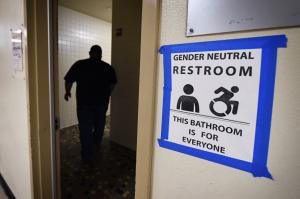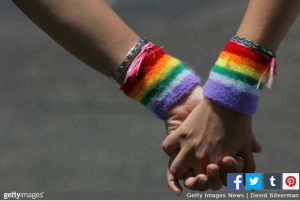
One afternoon in Ithaca, N.Y., my kids were playing on the swing sets in the park when a little tike wearing a football jersey ran into my daughter’s path. I lunged for the swing — I jerked the chain so abruptly that I feared whiplash — and shared a “wow, that was close” exchange with the kid’s mom.
“How old is he?” I asked. The lady looked at me as she placed her kid on the swing and said with no trace of irony, “His name is Jill, and she’s three.”
As I tried to match the pronouns and antecedents, she explained that she belonged to a group of parents who rebelled against gender stereotypes, allowing their children to decide their genders after they’d been exposed to both options. I’d learned of this in a philosophy class at NYU. My professor argued that children are born with “sex” but taught “gender.” The claim is that children unwittingly learn certain gender signifiers that dictate their behavior. Little boys don’t naturally want to play with trucks, and little girls aren’t naturally drawn to dolls, if unsullied by eager parents who try to indoctrinate their children with heterosexist ideas about “gender.” According to my professor, gender roles cause people to live according to the very limited ideas of others. The ultimate goal, of course, is androgyny, where no differences between males and females exist.
“I’m going to raise her as gender-neutrally as possible and let him decide which gender she prefers at the age of eight.” (Oh, eight; that’s the age at which my son dug up our Tennessee yard one square foot at a time, because he was convinced pirates had buried treasure there.)
Whenever I write about Ithaca (as I did in one of my memoirs), I invariably get e-mails asking, “Really?”
Understandably, people can’t quite believe that there are parents like this in America. However, a recent New York Times article called, “What’s So Bad About a Boy Who Wants to Wear a Dress?” attempts to further push the normalization of gender-confused children into the mainstream. It includes a very similar playground anecdote:
One day this spring I went to a playground with an 8-year-old boy named P. J. A pink ribbon with sparkly butterflies held back his thick black curls, which he occasionally flipped dramatically. He was wearing a serpent-and-skeleton bike helmet, a navy Pokémon T-shirt, black-and-pink stretch pants, a fuchsia sweatshirt and an iridescent heart necklace. As he and a friend raced happily around the park in a loud game of tag, they accumulated new pals.
After playing for half an hour, a few kids huddled to catch their breath and finally introduce themselves. One 10-year-old girl’s eyes opened wide. She turned to me, the closest adult. “Do you know she’s a he?” Yes, I nodded. Certain that I’d misunderstood, she pointed at P. J., who was right next to her. “No!” she said. “She is a he!”
The article, by Ruth Padawer, a professor at the Columbia University School of Journalism, examines how various parents deal with children when they don’t seem to fit into traditional gender roles. Padawer — and psychologists — describe this “condition” in the following flowery terms: gender-atypical, gender-fluid, gender-variant, gender-creative.
Parents Susan and Rob have one of these “gender creative” youngsters. Consequently, they sent an e-mail to the parents of their son’s classmates explaining their child will sometimes be wearing a dress to preschool. They explained that their son “has been gender-fluid for as long as we can remember, and at the moment he is equally passionate about and identified with soccer players and princesses, superheroes and ballerinas (not to mention lava and unicorns, dinosaurs and glitter rainbows). . . . The important thing was to teach him not to be ashamed of who he feels he is.” When Susan let her son wear dresses around town, however, her son was upset when strangers assumed he was a girl. He said, “I just hate being misunderstood.”
Other parents have paid for a half-day of gender-diversity training for the staff their kid’s school, though it doesn’t stop teasing during recess.
Padawer goes to great lengths to make sure her readers accept the “‘middle space’ between traditional boyhood and traditional girlhood.” She writes, “But the parents of the boys in the middle space argue that gender is a spectrum rather than two opposing categories, neither of which any real man or woman precisely fits.” Padawer then goes on to write that this “middle space” is more acceptable these days in the form of the transgendered. The “visibility of transgender people — be it running for office or tangoing on Dancing With the Stars — has provided an opening for those who fall between genders.”
The most astonishing quote of the article was from Edgardo Menvielle, head of a program for gender-nonconforming youth at Children’s National Medical Center in Washington. He said, “I would argue it’s not even ethical to say to a child, ‘This is the gender you must be.’ ”
The author helpfully explains what we already know about the political persuasion of the parents of these children, “Many of the parents who allow their children to occupy that ‘middle space’ were socially liberal even before they had a pink boy, quick to defend gay rights and women’s equality and to question the confines of traditional masculinity and femininity.”
In other words, I wasn’t exaggerating about what my professors at NYU taught about gender and sexuality, and I wasn’t exaggerating about what I saw on the playground in Ithaca.
Though, believe me. I wish I had been.
This article first appeared on National Review’s Home Front Blog.
Read more on the Faith and Family Channel
- Chick-fil-A, Boycotts, and our Freedom
- Scenes from a Chick-fil-A in Tennessee
- The Profound Theological Awesomeness of the Superman Trailers
- What is the Predominant Religion on The Bachelorette?
- Justin Bieber: Abortion is Killing a Baby
- Office Depot’s Lady Gaga Initiative Insults True “Bravery”
- I’m a White Republican Raising a Black Child: Deal with It
- Follow me on Twitter and Facebook!









